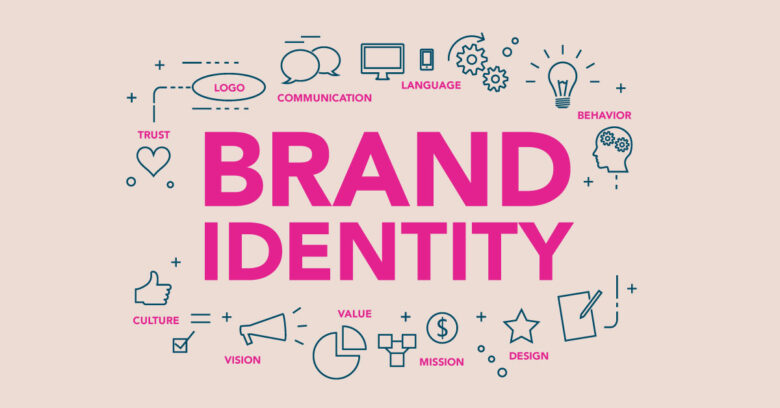Brand personality and brand identity are important parts of a business and have a big impact on its marketing strategy.
Despite all too often being used synonymously, the terms “brand identity” and “brand personality” are actually NOT the same thing, although they are strongly linked and both fall under the overarching term “branding”.
The confusion is understandable. One of brand identity’s many other names is “brand imagery”, while brand personality is often referred to as “brand image”. It’s also common for both terms to individually be referred to as a company’s “brand”!
What’s the difference?
The two terms are undeniably linked but they are, in fact, distinct entities. The biggest difference between the two is who controls them.
Brand Identity is the assets a company uses to present itself to the world; including its logo, brand colours, brand ambassadors, product design and focus, packaging, staff uniforms, advertising messages and countless other cues. Any unique assets that can be identified as belonging to that brand are a part of its brand identity. Assets are carefully constructed, with teams of marketing professionals dedicated to ensuring that each element of a brand’s identity effectively contributes to how the company wants to be viewed.
Brand personality, on the other hand, is a set of human characteristics that are attributed to a company by its consumers, or how that company would be described if it were a person. While brand identity is controlled by the business, brand personality exists inside the minds of consumers, so it can be influenced but not directly controlled by the business that it belongs to. As Ross Pike, Marketing Director of Quadrant2Design put it “today a brand’s personality is less about who they say they are and more about who their audience thinks they are”.
Brand Identity

Source: rvncreative.com
These are the assets that consumers associate with a brand. They are owned and controlled by the business and typically reflect how that business wants to be perceived by its consumers. Below are some well-known examples of companies and their brand identities.
If you want to learn more about high-quality branding, check out this creatingonline.com article.
McDonald’s
The “Golden Arches” logo, the red and yellow colouring, the “I’m loving it” tagline and even the restaurant furnishings are all instantly recognisable as belonging to McDonald’s.
Over the years, the company has moved away from using its clown mascot, Ronald McDonald in its marketing. Even so, as a big part of their history, Ronald McDonald still forms a part of McDonald’s brand identity, only now he is an element of who they were, rather than who they are.
Nike
Very few companies have a logo as instantly recognisable as Nike’s swoosh. Combine this with their “Just Do It” tagline and bold, no-nonsense block font and most people can recognise the Nike brand from a mile away.
The company has a long history of endorsements from successful athletes and almost always has a presence at whichever sporting event the world is watching.
Pandora
Pandora’s logo is instantly recognisable for its distinctive crown over the “O”. Their shops have a unique layout, using island-style cabinets rather than the typical jewellery store counters.
The company uses a white or black logo, typically complemented by pink or pearl, and is immediately identifiable by its distinctive charms bracelets.
Apple
Apple’s brand identity centres on its “bitten apple” logo, sterile white and sleek metallic colouration and product names beginning with the letter “i”.
The company’s open, minimalistic stores are consistent with their minimalistic marketing messages. The original iPod advert was a perfect example of this, with simple silhouettes of a person and an iPod on a colourful background.
Harley-Davidson
Harley-Davidson’s brand identity is rooted in its distinctive visuals. The company’s orange, white and black logo is shaped like a hood ornament and is often complemented by the wings of an eagle.
Their marketing typically focuses on a combination of rugged landscapes and stereotypically masculine visuals like engines, metalwork and beards.
Even the distinctive sound of a Harley-Davidson engine is an element of its brand identity. It’s loud, booming and easily identifiable.
Brand Personality

Source: sunsigndesigns.com
Brand personality is developed in the minds of consumers largely based on their interactions with brand identity. Below are examples of how these companies have used their brand identity to create the desired brand personality.
McDonald’s
McDonald’s brand personality is unique in that it has little to do with its product offering. It’s less about selling burgers and fries than it is about feel-good moments, warmth, inclusivity, happiness, sincerity and family-friendly fun, matching its long-standing tagline “I’m loving it” tagline.
The brand’s colour choices combine the happy energy of yellow with the bold intensity of red to project a personality that’s cheerful and confident, unpretentious, welcoming and dependable.
Personality summary – fun, family-friendly, welcoming, dependable, cheerful, confident.
Nike
Nike has a very sports-based brand personality, centred on athletic success. An unintended coincidence according to Nike Co-Ceo Phil Knight, the swoosh logo is reminiscent of a tick, which helps to portray Nike’s personality as that of a winner.
The company’s long history of endorsements from successful athletes creates a natural association with athletic achievement, competitiveness and uniqueness. The slogan “Just do it” represents doing your own thing as a leader in your field.
Nike’s use of black and white for its marketing projects a bold and powerful personality, while its orange branding represents its enthusiasm, success and confidence.
Personality summary – athletic, competitive, confident, exciting, cool, successful.
Pandora
Pandora’s personality combines individuality, femininity and luxury. The brand’s logo includes a crown (a symbol of prestige), while the use of black on white projects authority and power amongst peace and tranquillity. The regular use of pink and red serves to associate Pandora with femininity and romance.
By anchoring its brand identity in its customisable charm bracelets Pandora has focused its brand personality on uniqueness and standing out from the crowd.
Personality summary – unique, feminine, romantic, luxurious, sophisticated.
Apple
Apple’s personality focuses on simplicity and precision, with an air of exclusivity. It’s smart and it knows it.
The combination of bright white and metallic silver is reminiscent of a scalpel on a sterile surface. It portrays Apple as sleek, clean and expert; getting the job done like a surgeon.
It’s portrayed as intelligent and minimalistic, which is evident in not only its marketing messages but also in the layout of its stores. This minimalism highlights Apple’s straight-to-the-point attitude, getting things done with no wasted effort.
This, combined with the company’s use of the letter “i” in the majority of its product names, cements it as an undisputed authority in the technology and information sector.
Personality summary – intelligent, precise, confident, minimalistic, straight-to-the-point.
Harley-Davidson
Harley-Davidson is rugged, powerful, free and proudly rebellious. A cult brand, Harley-Davidson simultaneously represents individualism and belonging. The black, orange and white logo combines power and boldness with energy and confidence and projects the brand as someone who knows who they are and isn’t sorry about it.
The landscapes used in marketing messages, combined with the regular use of eagle wings, highlight the brand’s freedom to roam while the stereotypically masculine imagery and even its booming engine, cement its ruggedness.
Personality summary – rugged, rebellious, powerful, bold, free.
Why does it matter?

Source: seismic.com
It’s important for marketers to understand the differences and links between the two terms, as it’s through the use of brand identity that companies are able to effectively portray their desired brand personality.
Just as brand personality is influenced and shaped by brand identity, the most successful companies also allow this to work in reverse. While building their brand identity, companies should be deliberate and ensure that each individual element is effectively contributing to the personality that they want their brand to be associated with.
If significant gaps are found between a company’s desired brand personality and its actual brand personality, then changes can be made to elements of its brand identity to close these gaps.
A positive and consistent brand personality will allow a business to form personal relationships with its customers and set itself apart from the competition. Similar to how people gravitate towards the people they like and try to stay away from the people they don’t, consumers also naturally develop preferences for brands they like and are more likely to buy from those brands.
By understanding and utilising the links between the all-too-often confused terms, companies can more effectively project their brand identity and, as a result, successfully produce their desired brand personality.
